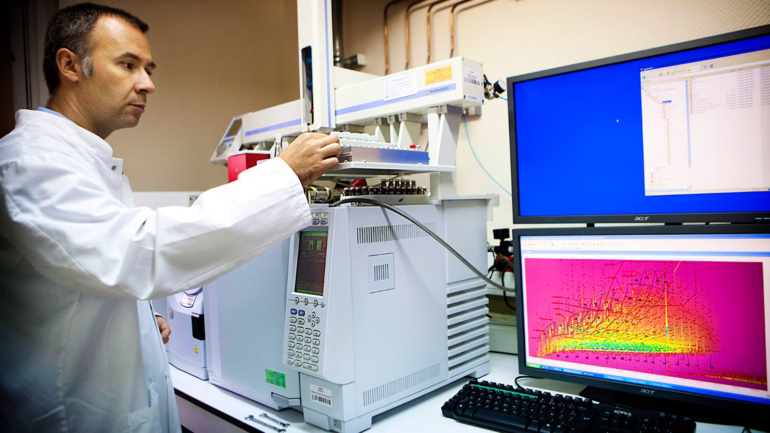TL;DR:
- Scientists employ AI and gas chromatography to analyze 80 wines, revealing their terroir.
- XY coordinate mapping of wine chemical signatures validates the concept of terroir.
- Gas chromatography’s labor-intensive process is streamlined with machine learning.
- Wine producers identified with 100% accuracy; vintage recognition at 50%.
- Research aids in fighting wine fraud and adapting to climate change.
- Potential to expand research to other wine varieties and applications.
- Transformation of basic science into practical solutions is envisioned within 2-4 years.
Main AI News:
In the world of wine, where tradition and technology often collide, a remarkable convergence has emerged. Artificial intelligence, the beacon of modern innovation, may not savor the nuanced flavors of a fine Bordeaux, but it can astutely trace its origins. In an extraordinary study, scientists have harnessed the power of machine learning and gas chromatography to scrutinize 80 wines meticulously, uncovering the secrets of their birthplaces. Astonishingly, the wines, when plotted as XY coordinates on a map based on their chemical signatures, clustered precisely according to the Left and Right Bank regions of Bordeaux. This pioneering research underscores the venerable concept of terroir and promises profound implications for the world of oenology.
Published in the prestigious journal Communications Chemistry, this groundbreaking endeavor was led by Alexandre Pouget, a computational neuroscientist at the University of Geneva, and research enologist Stéphanie Marchand of the Institute of Vine and Wine Science (ISVV) at the Université de Bordeaux. The fusion of wine passion and scientific acumen set the stage for this remarkable journey.
For Pouget, a native of Paris with a lifelong affinity for wine, the quest to apply machine learning to viticulture had lingered for decades. His expertise in studying the brain using machine learning during the late 1980s took him from the bustling streets of Paris to the tech hubs of California and New York, eventually leading him to Geneva. Yet, the question of whether machine learning could decode the mysteries of wine remained unanswered until a fateful visit to Veuve Clicquot six years ago. It was during this private tasting that he shared his idea with the winemaking team, which eventually led him to Bordeaux’s ISVV and to Marchand, a specialist in wine chemical analysis. The project took its modest beginnings as a “Saturday experiment” in the ISVV’s chemistry lab, as recounted by Marchand.
The crux of the experiment lay in the fusion of gas chromatography (GC) and electron ionization mass spectrometry with the computational prowess of machine learning to identify wines based on their molecular signatures. Two fundamental questions were posed in their research: Could the estate be identified independently of the vintage, and could the vintage be identified independently of the estate? Gas chromatography, a longstanding tool in wine analysis, vaporized the wine and generated a data-rich chromatogram. However, the labor-intensive task of manually quantifying the chromatogram’s peaks presented a significant challenge. Pouget, drawing from his neuroscience background, introduced machine learning to navigate the vast dataset efficiently, eliminating human biases and enhancing precision.
Marchand approached seven classified-growth châteaus, their identities shrouded in secrecy, selecting 12 vintages spanning from 1990 to 2007. The algorithm was trained using the chromatograms of 73 wines, followed by testing with seven additional wines. The results were nothing short of remarkable: the machine accurately identified the estate 100% of the time, whereas it correctly identified the vintage 50% of the time.
Initially, the researchers speculated that the results might be attributed to the grape varieties used in the blends. However, the entire chromatogram proved to be indicative of both geographic origin and age, suggesting that a wine’s chemical identity transcends a mere handful of molecules and encompasses a broad chemical spectrum.
The true revelation came with the XY coordinate mapping of the chromatograms, where wines from the same estate but different vintages clustered together, forming a spatial representation of Bordeaux’s appellations. This chemical fingerprint revealed a geographic commonality among wines, showcasing their similarities. The implications of this discovery were profound, igniting excitement among the researchers.
Beyond unraveling the mysteries of wine, this research has practical applications. It could combat wine fraud by accurately identifying a wine’s producer, aiding law enforcement in their efforts. Moreover, in an era of climate change, the chemical analysis facilitated by machine learning could provide valuable insights into how a wine’s typicity is evolving, empowering winemakers to adapt while preserving the historical identity of their creations.
As the team’s research expands, venturing into the realms of Pinot Noir and Syrah, and delving into wines from modest estates, the potential for further revelations in wine chemistry and machine learning remains boundless. While practical applications are yet to be fully realized, Pouget envisions two to four years of dedicated work to transform this basic science into tangible solutions.
Conclusion:
This groundbreaking research that combines AI and chemistry to unravel the terroir of wines not only validates a fundamental concept in winemaking but also opens up possibilities for combating fraud and adapting to climate change. As this technology matures, it could reshape how the wine industry approaches production, quality control, and market positioning, offering a new level of precision and authenticity to consumers and producers alike.

